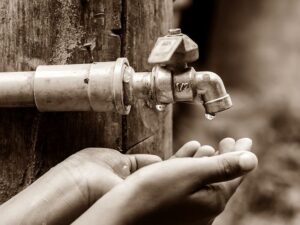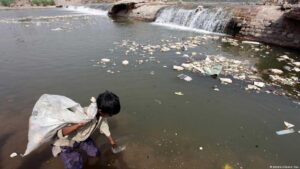The 2021-22 Union Budget announced the launch of the Jal Jeevan Mission (Urban), an ambitious project that aims to provide potable tap water supply to 2.86 crore households by Urban India is fast hurtling towards a major water crisis in the years to come. A 2020 report by the World Wide Fund for Nature (WWF) has projected that 30 Indian cities will face a ‘grave water risk’ by 2050 due to overcrowding in cities.
A Niti Aayog report too had predicted that 21 Indian cities including New Delhi, Chennai, Bangalore and Hyderabad will run out of groundwater by 2020 affecting 100 million people.
Major water concerns in urban areas
Taps run dry in majority of the cities
As high as 31 percent of urban households in cities, mostly those who live in unauthorised colonies and slums, do not have access to piped water or public tap water and even the existing taps run dry for most of the time. And what’s more – most Indian cities cannot even meet the per capita water supply requirements of 135 litres per day as specified by the Central Public Health and Environmental Engineering Organisation!
Increasingly unable to meet the 24×7 water supply needs of the population, the public supply infrastructure continues to be marred with challenges such as ageing infrastructure, lack of operation and maintenance, low pressure in the pipes and poor revenue mobilisation mechanisms.
 Photo courtesy: Honors College
Photo courtesy: Honors College
How will this work out for urban India? This lack of availability of piped water supply and over dependence on wells and borewells to compensate for the gap in water supply has led to over exploitation of groundwater resources in many cities. As high as 48% of India’s urban water supply comes from groundwater, and in seven of India’s 10 most populous cities, groundwater levels have dropped dangerously over the past two decades.
Mismanagement of water adds to the water woes
Glaring mismanagement of water in cities leaves even the water rich areas starved for water. For example, a recent analysis shows that abundance of groundwater availability in the top five cities like Ludhiana, Amritsar, Rajkot, and Vishakhapatnam does not help its residents due to increase in population and inefficient management and allocation of the available water. Bottom five cities in terms of groundwater availability include cities such as Chennai, Bangalore, Chandigarh, Dhanbad, and Ghaziabad. Water cuts across administrative boundaries makes some states dependent on neighbouring states for water leading to water disputes.
Another working paper on the state of water in six Indian cities conducted by the Kubernein Initiative finds that in Chennai and Bengaluru, water resources are overworked and overused, not adequately replenished, and recharge areas have been destroyed due to construction and concretisation. Mumbai and Kolkata, although not water scarce, continue to face water stress due to unequal distribution of water, over dependence on monsoon and over consumption of water.
Read more: Can individual water metering help Indian cities avoid Doomsday?
For example, while Kolkata has water hydrants to cater to the needs of the poor, they are the largest culprits of wastage in the city. The informal settlements in Mumbai suffer hugely due to lack of access to water connections while Delhi being naturally water scarce has to depend on neighbouring states for its water supply.
The working paper informs that most cities in India have poorly laid-out infrastructure plans and fluctuations in water availability increase dependence on groundwater that is depleting at dangerous levels.
Besides this, lack of proper disposal and treatment of sewage is a common problem in cities that not only leads to choking of drains and flooding, but also leads to poor quality of water due to contamination and mixing of sewage with drinking water. Besides other competing water needs, agricultural activity in the periphery of many cities also in constant battle with urban management over the sharing of water resources.
Only about 35 percent of wastewater is treated in India and the use of treated wastewater for non potable uses at the household is still largely lacking because of strong stigma associated with using treated wastewater.
The available water is of poor quality
In urban India, 50 million people in 15 cities have no access to safe, affordable drinking water, reveals a UNICEF India report. Since piped water is inadequate in most of the cases, drinking water in cities is often procured from a variety of sources such as borewells, private wells, tankers or bottled water. But very little information exists on the quality of this water that is made available to the people.
And this water from major sources like tube wells and hand pumps is also found to be unsafe as they are known to be carriers of waterborne diseases. Even where piped water is available, its quality continues to be questionable. A large proportion of people do not have access to water within the house, increasing the chances of infections.
 Photo courtesy : Made For minds
Photo courtesy : Made For minds
Surface water sources too are highly contaminated in India. Poor sewage disposal mechanisms lead to most of the untreated sewage being drained into rivers and lakes that serve as reservoirs of microbial contamination. Poor access to safe water sources and toilets and open defecation and poor WASH practices lead to high instances of waterborne diseases in the country.
Release of untreated industrial and pharmaceutical wastes into the surface water sources has led to dangerous levels of organic and inorganic pollutants into the surface water bodies in India, making it unfit for consumption.
Read more: Kolkata’s ignored groundwater crisis could lead to much more than just water shortage
Groundwater resources in the country have also been found to be highly polluted due to presence of fluoride, arsenic, nitrates, iron, heavy metals as well as due to leaching of harmful pesticide and fertiliser residues. Toxins from untreated industrial wastes and landfills as well as bacterial contaminants from the surface soil and water sources can also contaminate groundwater. Even bottled water in India continues to be unsafe for consumption.
Key points emerging from these studies
- Accessibility of water for low income communities in many of the cities continues to be a problem and needs to be addressed as these communities form an important section of the population in cities.
- Most Indian cities do not segregate and process grey and black water discharges. A large part of wastewater is discharged into unlined stormwater channels, which leads to contamination of the groundwater.
- Poor water quality continues to plague most of the Indian cities
- The water infrastructure in cities is outdated and is unable to accommodate the different levels of water, store it for future use and augment supply with alternative sources.
- Rampant development in all these cities continues to threaten natural habitats and water bodies that help in water conservation and flood prevention, such as marshlands, wetlands, floodplains, embankments and others.
- Lack of data and outdated infrastructure leads to huge water losses. Excessive emphasis on supply side solutions to procure water leads to poor attention being paid to demand management and exploration of alternatives
- Lack of coordinated efforts at the policy level hinder progress
What needs to be done for the long term success of JJM?
The studies and recent analysis recommend that the strategy to meet the water crisis in urban areas should be based on the following steps:
- Generating data on the state of water resourcesnot only in terms of supply, but also quality and demand at the level of citizens, communities and industry.
- Identification of vulnerable areasand focusing on allocating resources to them on a priority basis
- Use of technology right from the source to the userto improve water use efficiency and achieve transparency in data sharing
- Moving away from thecurrent linear water management to a data-driven circular water management approach for managing urban water resources that requires multi-stakeholder engagement.
- Better participation and investment in the water sector by ensuring a dialogue with citizenson the need for water pricing, involving the private sector and finding ways to make a financially sustainable revenue model.
- Ensuring water use efficiency across all sectors and reallocating water across sectors without compromising productivity
- Reinforcing the understanding that urban management is about aligning governance, public policy, financial and regulatory frameworks and water security initiatives and systems.
Neerain is proud to republish this article for spreading awareness about situation of water, for our stakeholders. Credit whatsoever goes to the Author.
This article is published by: –
https://citizenmatters.in/urban-water-shortage-contamination-groundwater-wastage-water-management-26866
We would like to spread this for the benefit of fellow Indians.
Author : Aarti Kelkar Khambete
Publish On: August 5, 2021
